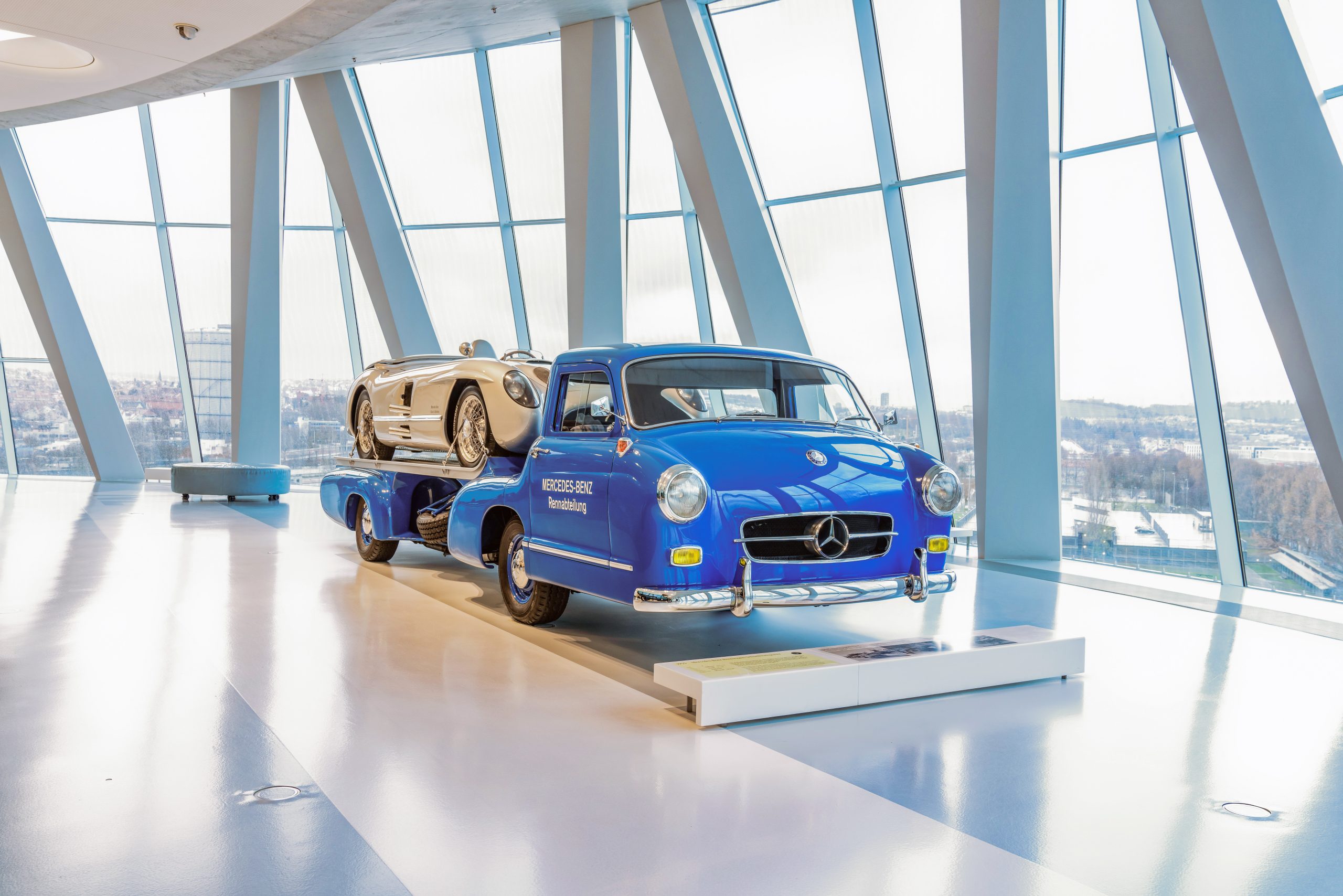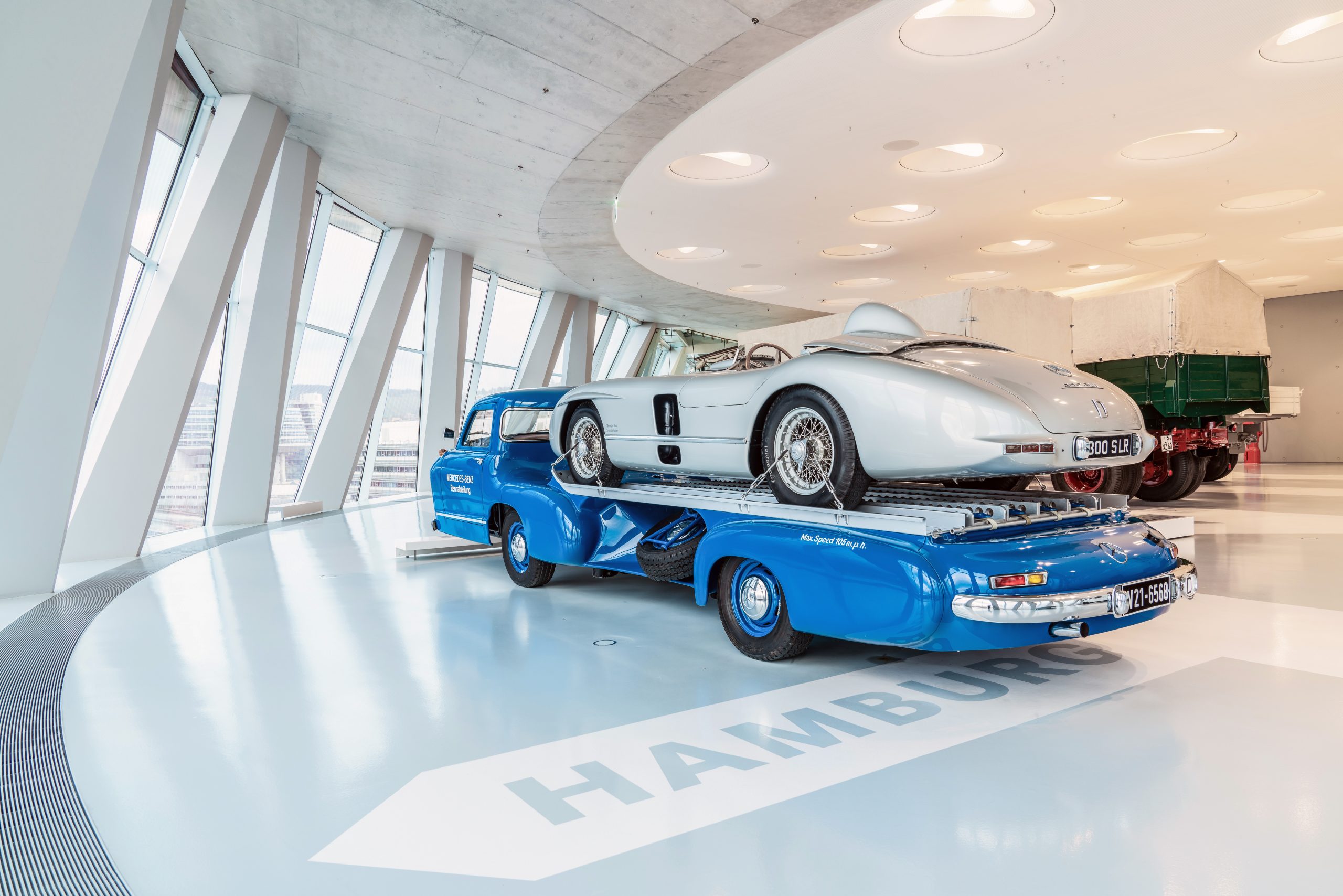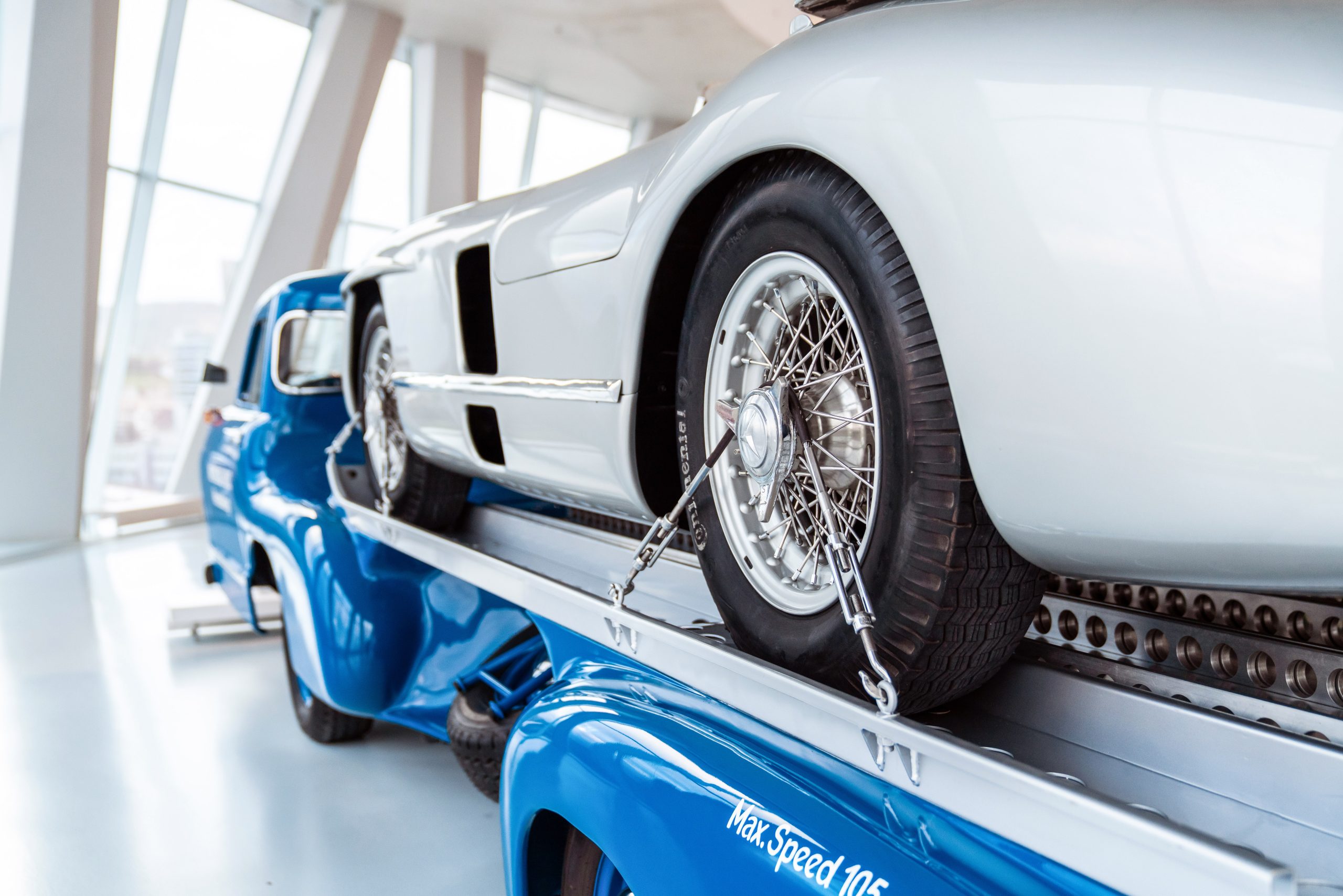• De snelle racewagentransporter voor het autosportseizoen 1955
• Gesculpteerd uiterlijk en hoge kruissnelheid
• Snel transport van race- en racesportwagens tussen de fabriek en race-evenementen
• Efficiënt gebruik van componenten uit productieauto’s uit die tijd
Stuttgart. “Close-up” – the name of this series from the Mercedes-Benz Museum says it all. Each instalment tells a surprising, exciting or behind-the-scenes story. By shining a spotlight on details of a vehicle, an exhibit or an architectural or design feature. In the spotlight this time: the high-speed racing car transporter for the 1955 season.
No. 5/2023: High-speed racing car transporter
A work of art: Visitors to the Mercedes-Benz Museum can see the “Blue Wonder” in Collection Room 2: Gallery of Carriers. The high-speed Mercedes-Benz racing car transporter for 1955 is displayed here to Museum visitors almost as a sculptural interpretation of speed. Flowing forms envelop the vehicle with its rich blue paint finish. The vehicle is an authentic reconstruction.
Speedy load carrier: Originally, it was built in the Mercedes-Benz test workshop in 1954 for the following year’s motor racing season. There is no separation here between the driver’s cab and the load platform, as is the case with conventional commercial vehicles. Instead the body of the transporter appears to have been cast from a single mould. The silhouette is decidedly sporty: the cab, positioned ahead of the front axle, crouches to hug the road. And the rear mudguards proudly proclaim “Max. speed 105 m.p.h.”. This translates to a top speed of 170 km/h, which was more than respectable at the time. The maximum speed was apparently recorded on the paintwork at the end of the 1955 season – as documented by historical photos.
Exclusive cargo: The purpose of the high-speed racing car transporter is demonstrated by the exhibit in Collection Room 2 – Gallery of Carriers of the Mercedes-Benz Museum: a 300 SLR (W 196 S) is lashed to the load platform. It was with these racing sports cars that Mercedes-Benz won the World Sports Car Championship in 1955. The high-speed racing car transporter was used to carry the 300 SLR as well as the W 196 R Formula One racing cars all over Europe during that season. It was the fast and essential link in the time-critical logistics between the plant in Stuttgart and the race tracks.

Mercedes-Benz Museum, Collection Room 2 – Gallery of Carriers. Mercedes-Benz high-speed racing car transporter for the 1955 motorsport season. Authentic reconstruction from 2001. On the loading platform, a Mercedes-Benz 300 SLR racing sports car (W 196 S) with air brake. Photo from the front right.
Number 1 with air brake: The racing sports car on the high-speed racing car transporter on display in the Mercedes-Benz Museum was the first example of this model series to be produced. Its special feature is the air brake behind the driver’s seat. This was extended during braking from high speeds, relieving the strain on the drum brakes. The 300 SLR cars used in the Le Mans 24-hour race and the Swedish Grand Prix featured this air brake.
“Blue Wonder”: Mercedes-Benz motorsport fans back in 1955 were delighted by the transporter. In contrast to the well-proven racing car transporters based on Mercedes-Benz trucks, this one-off stood out from the crowd thanks to its unique appearance, elegance and speed. These attributes, together with the blue paintwork typical of Mercedes-Benz service vehicles, soon earned the vehicle the nickname “Blue Wonder”.

Mercedes-Benz Museum, Collection Room 2 – Gallery of Carriers. Mercedes-Benz high-speed racing car transporter for the 1955 motorsport season. Authentic reconstruction from 2001. On the loading platform, a Mercedes-Benz 300 SLR racing sports car (W 196 S) with air brake. Photo from the left rear.
Family resemblance: Only one example of the high-speed racing car transporter was built, for the 1955 motor racing season. Nevertheless, the one-off was closely related to the production vehicles of the time. This is because the engineers and designers used numerous components adopted from the passenger cars produced in the mid-1950s: the suspension, for example, came from the highly exclusive 300 S (W 188). The “Ponton” saloon (W 120) in the upper medium class contributed numerous body parts. The six-cylinder M 198 engine with a displacement of 2,996 cc, on the other hand, came from the 300 SL “Gullwing” super sports car (W 198). In that car the engine developed 158 kW (215 hp) at 5,800 rpm, while in the high-speed racing car transporter it delivered 141 kW (192 hp) at 5,500 rpm. The radiator grille with the central Mercedes star is reminiscent of the production sports cars, racing sports cars and racing cars of the time.
Distinctive shape: The various standard components were harmoniously blended into a design all of its own. The flowing design idiom of the cab continues through to the rounded rear end. The design is accentuated by chrome trim, from the bumpers to the surrounds of the windows and headlamps. The two-section rear window makes a particularly organic impression. Its glass surfaces follow the shape of the cab, curving around the cab and inwards at the same time.
Comfortable workplace: The interior of the transporter was designed for long-distance comfort. The typical chequered fabric used in the racing and sports cars of the time adorns the seat and backrest surfaces as well as the door panels. The dashboard is trimmed in leather, the centre tunnel in fabric. Behind the large steering wheel, the rev counter and speedometer are optimally positioned within the driver’s field of vision. Marked maximum speed: 140 km/h
Manual loading and unloading: The crew’s comfort, however, came to an end when loading and unloading. Because there are no mechanical aids such as a tail lift. Instead, four lightweight rails are stowed on the vehicle between the guides for the racing car’s wheels. These were latched to the rear and supported about half-way down to form a ramp for the precious cargo. At major road races without their own pits, the rails also served as an improvised workshop ramp – for example, at the 1955 Targa Florio in Sicily.
Authentic reconstruction: The original 6.75-metre-long high-speed racing transporter, with a wheelbase of 2.9 metres, no longer exists. After the brand’s withdrawal from motor racing at the end of the 1955 season it was used by the road-test department, before being scrapped in 1967. The former Daimler-Benz AG had this unique vehicle recreated as an authentic reconstruction based on historical documents from the Mercedes-Benz Classic Archives. The project was successfully completed in 2001. Since then, fans of the Mercedes-Benz Silver Arrows have once again been able to admire the “Blue Wonder”.

Mercedes-Benz Museum, Collection Room 2 – Gallery of Carriers. Mercedes-Benz high-speed racing car transporter for the 1955 motorsport season. Authentic reconstruction from 2001. On the loading platform, a Mercedes-Benz 300 SLR racing sports car (W 196 S) with air brake. Close-up of the lashing system used to secure the load.









